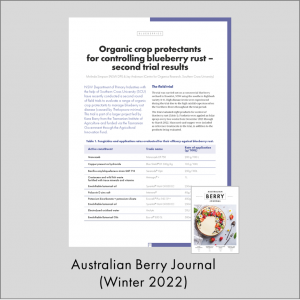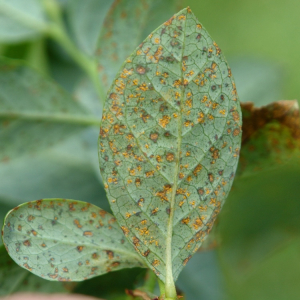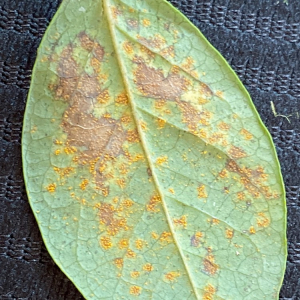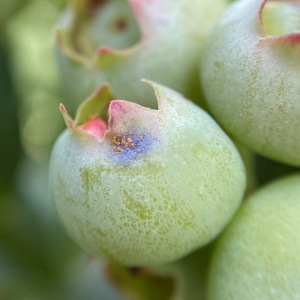Identifying & Managing Blueberry Rust
Blueberry rust thrives in warm, wet conditions, especially when there are extended periods of leaf wetness and susceptible host tissue is present. The disease is caused by the fungus Thekopsora minima.
The fungus primarily infects leaves, causing a reduction in plant vigour and fruit set. When fruit is infected, marketability can be affected.
Management of blueberry rust requires an integrated approach, including:
- scouting of orchards to detect early infections
- monitoring of weather to identify conditions conducive to the infection and development of disease symptoms
- cultural measures
- targeted application of fungicidal sprays
Berries Australia have published a range of articles about Blueberry rust and these have been collected together here.
Poster: Managing Rust in Blueberries
Rust Management Guide – ABJ Autumn 2021
Organic Crop Protectants – ABJ Summer 2021
Organic Crop Protectants – ABJ Winter 2022
TIA Blueberry rust management in a cool climate
NSW DPI Berry Plant Protection Guide
SYMPTOMS
Images are reproduced here with thanks to the copyright owners: Scot Nelson, Rosalie Daniel, Melinda Simpson & Jay Anderson
Leaves
Rust first appears as small pale-bright yellow lesions on the upper surface of infected leaves. On the underside of the leaf, the fungus erupts through the surface and small pustules containing spores form.
As the disease progresses, the lesions become red to brown in colour and may increase in size, coalescing when disease is severe.
The spores are powdery when touched, and when there are many, they may be seen to float with air currents or wind.
The infected tissue within the lesion becomes darker as it dies, reducing the photosynthetic capacity of the leaf.
When disease pressure is high, defoliation may occur.
Fruit
Lesions develop on ripening fruit when disease pressure is high.
Rust lesions can reduce the marketability of ripe berries.
It is likely that infection takes place during flowering.
Fungal DNA corresponding to T. minima has been detected in flowers and ripening asymptomatic fruit.
The infection process needs to be confirmed microscopically.






















